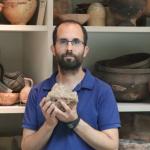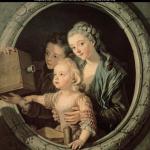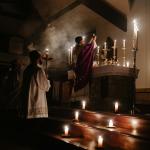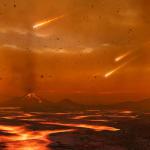History is a difficult science. To determine what happened in the past and why it happened is an important prerequisite for understanding the present and is useful if one wants to explore the possible future for humanity. Christians are free to take all the data available to them and explore such events in many different ways. They can take all the stories they find about an event and try to create a synthetic presentation of what happened. They can take all the data they find and try to explain why it happened according to the will of God or according to how God acted upon his will. Historians often will try to explain the event and how it came about all at once.
Since historians are dealing with imperfect data, the description of the historical event and why that event happened can radically differ from historian to historian. Nonetheless, it is important to try to take everything into account, no matter the source, and to provide the best presentation possible, even if it means exploring and using data from questionable sources. This, for example, is what we find St Albert the Great does with his exploration of Noah’s flood. “For there was a universal flood that submerged the entire habitable earth, as occurred at the time of Noah, as Moses recalls, which I think was the same flood that occurred at the time of Deucalion and Pyrrha, as the Greek and Latin poets attest.”[1] One can note here that St. Albert is willing to accept pagan myths as a source for history. While he does not say it, he implies that he is willing to accept the people in those pagan myths as being survivors just like Noah and Noah’s family, showing that he is willing to add data from non-Scriptural sources to create a history of the flood.[2] This means Scripture alone is not his source for reconstructing history, and, for him, pagan knowledge and wisdom are an important part of such reconstruction. Christians are free to look to the pagans and learn from them, and indeed, investigate what they have to say, and use it to better understand their own faith, even to understand salvation history.
St. Albert, however, is not so much interested in detailing the events of the flood, but how it came about. He is interested in what could be said to be “scientific history.” He points out that it is true we can say it happened because it was God’s will, but he also thinks this is not a sufficient explanation of the event. We need to understand how God’s will is enacted, and that means, we need to understand the natural causes used for God’s will:
There are, however, some who attribute all these things to a divine disposition alone and who say that we should seek no cause for things of this sort other than the will of God. We agree with them in part, because we say that these things occur by the will of God, who governs the world, as a punishment for the evildoing of men. But we still say God does these things on account of a natural cause, of which he who confers motion on all things is himself the first mover. However, we are not seeking causes of his will, but we are seeking the natural causes that are like certain instruments through which his will in such matters is brought into effect.[3]
Scientific pursuit of how the world works does not go against theological explanations for why the world exists. The two go together, and the Christian, using the gifts God has given them, should be encouraged to explore the world and how it works without fear of it somehow denying the involvement of God’s will in creation. To explore creation through natural causes, such as we find in evolutionary science, cannot be said to explore God’s will but only the way God’s will has been enacted. The Christian or the atheist who confuses the different kinds of causes and equivocates them equally harms the pursuit of science from equal but opposite directions. The formal, material, efficient and teleological causes relate to one another, of course, but they must be examined in such a way as they complement each other and not override each other.
The science of St. Albert’s day was rather crude, and it included fields of study which might surprise modern readers. For example, the influence of the stars and moon on the earth was seen as a legitimate scientific pursuit. They knew and could prove the moon had an influence upon the earth through the exploration of tides and this was used to demonstrate the influence the stars and planets must also have upon the world. Thus, for St. Albert, the scientific or natural explanation for the flood was what we would now consider to be an astrological solution:
With these things already established in this way, I say, therefore, that the cause of the universal flood is comprised of four causes, of which one was a true seven-planet conjunction. The second is that all or many of them were in the lower part of their revolutions. The third is that the conjunction was such that it began in the sign of Aquarius near the four stars which are called the Water Pot of Aquarius [Hydroa Aquarii] and which some call the Out-pourer of Water [Effusor aquae], because it was discovered that they have a special, wondrous effect in moving the waters. [. . .] The fourth and last cause is, however, that the moon was strengthened in its powers at the hour of conjunction, such that it was itself ascending from the circle of its hemisphere, and that this conjunction was directly over the water, and that it was at the hour and day of the moon. For then without doubt the moon had within itself whatever light was in all the planets. And the moon moves with all that light according to the nature of the moon, and for this reason the water did not then advance gradually but leapt forth, as it were, toward the moon from the deepest bowels of the earth.[4]
While astrological fatalism which tried to determine individual destinies was rejected by the Church because it undermined free will, the power and influence of the stars upon the natural elements was not rejected and was allowed to be explored. We can imagine, of course, what many today would say to St. Albert’s explanation if it were offered – people would not reject it because it gets the science wrong, but because it must be a “Satanic” explanation for its use of astrology. Astrology has been repudiated in such a way that people do not understand why it was rejected and what aspects of astrology were long respected and followed until the time that empirical science was able to denounce such claims.[5] For a Christian, however, distinctions are necessary, and one must understand not just the title of what has been condemned, but the actual reasoning for why it is condemned so not to lose out and reject more than is necessary.
What we learn, therefore, from St. Albert’s attempt to understand Noah’s flood is the universal approach that the Christian should take to history. They should be able to explore natural, scientific history and to use scientific history to explain events. They should also be willing to explore many perspectives, even non-Christian pagan sources, as a way to engage history, to find out what happened in it. Anything other than this, and one begins to degrade the faith by rejecting and jettisoning the use of reason. Such a faith is no longer is a faith seeking understanding but a blind and deadly fideism.
[1] Albert the Great, On the Causes of the Properties of the Elements. Trans. Irven M. Resnick (Milwaukee, WI: Marquette University Press, 2010), 71.
[2] Obviously, moderns would have a different take on the flood, and a willingness to see many local floods are being described through such myths.
[3] Albert the Great, On the Causes of the Properties of the Elements, 72.
[4] Ibid., 75-6.
[5] Obviously, not everything has been rejected; the power of the moon upon the earth, including upon the people of the earth, continues to be accepted, though how and why it influences people and their moods and activities has not been properly ascertained.















